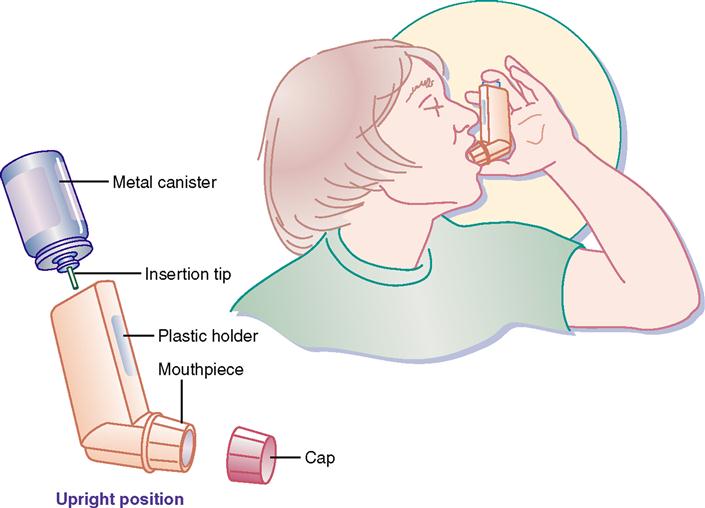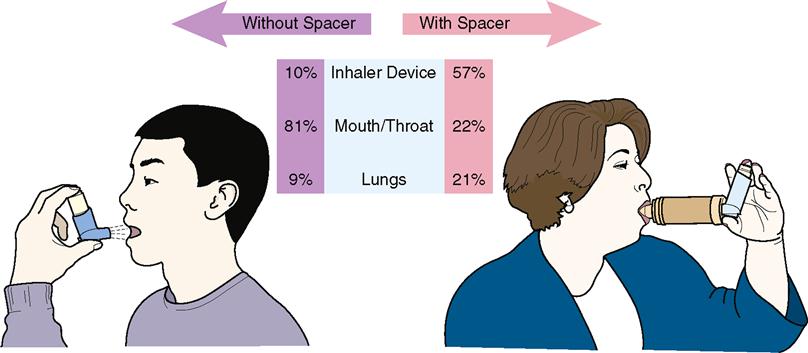ALTERNATIVE METHODS FOR DRUG ADMINISTRATION
Objectives
• Recognize the various methods for drug administration.
• Explain the steps (methods) in drug administration when the various methods are used.
Numerous methods are used to administer medications, in addition to the oral (tablets, capsules, liquid) and parenteral (subcutaneous, intradermal, intramuscular, intravenous) routes. Alternative methods for drug administration include transdermal patches; inhalation sprays; nasal sprays and drops; eye drops and ointments; ear drops; pharyngeal (throat) sprays, mouthwashes, and lozenges; topical lotions, creams, and ointments; rectal suppositories; and vaginal suppositories, creams, and ointments.
TRANSDERMAL PATCH
Purpose
The transdermal patch contains medication (Figure 5-1); the patch is applied to the skin for slow, systemic absorption, usually over 24 hours. Use of the transdermal route avoids the gastrointestinal problems associated with some oral medications and provides a more consistent drug level in the patient’s blood.
Method
Transdermal Patch
2. Label the patch with date, time, and nurse’s initials.
3. Remove the transparent cover (inside) of the patch. Do not touch the inside of the patch.
4. Apply the patch to the chosen area with the dull, plastic side up.
Note: There are some transdermal patches that absorb over 3 days (e.g., durgesic), some over 7 days (e.g., Catapres), and some over 1 month (e.g., contraceptive agents).
TYPES OF INHALATION
Purpose
The drug inhaler delivers the prescribed dose to be absorbed by the mucosal lining of the respiratory tract (Figure 5-2). The drug categories for respiratory inhalation are bronchodilators, which dilate bronchial tubes; glucocorticoids, which are anti-inflammatory agents; and mucolytics, which liquefy bronchial secretions.
Types
Inhalers can be divided into four groups: metered-dose inhalers (MDIs), MDI inhalers with spacers, dry powder inhalers, and nebulizers. Standard MDIs use a pressurized gas that expels the medication. Press the canister and inhale fully at the same time. Breath-activated MDIs are another type, in which the dose is triggered by inhaling through the mouthpiece; they require less coordination.
Spacer devices are used with MDIs and act as a reservoir to hold the medication until it is inhaled. These devices have a one-way valve that prevents the aerosol from escaping. Good coordination is not needed to use a spacer device.
Dry powder inhalers contain small amounts of medications that have to be strongly inhaled if the powder is to get into your lungs. This method is difficult for children younger than 6 years.
Nebulizers are devices that convert medication into a fine mist. The medication is usually prescribed in a prefilled dosette, which is placed in a nebulizer connected to a small compressor that aerosolizes the medication. The medication is inhaled via mouthpiece or face mask. Nebulizers are the choice for the weak, elderly, and small children and infants because no coordination is needed for this type of delivery.
Method
Metered-Dose Inhaler
2. Shake the inhaler well before using. Remove the cap from the mouthpiece.
3. Instruct the patient to breathe out through the mouth, expelling air. Place the mouthpiece into the patient’s mouth, holding the inhaler upright (see Figure 5-2).
6. If a second dose is required, wait 1 to 2 minutes, and repeat steps 3 to 5.
Method
Metered-Dose Inhaler with Spacer
This method is similar to an MDI with the following additions; see Figure 5-3.
Stay updated, free articles. Join our Telegram channel

Full access? Get Clinical Tree





